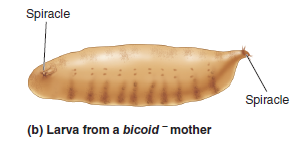
Genetics: Analysis and Principles 5th Edition by Robert Brooker
Edition 5ISBN: 978-0073525341
Genetics: Analysis and Principles 5th Edition by Robert Brooker
Edition 5ISBN: 978-0073525341 Exercise 8
Take a look at solved problem S3 before answering this question. Drosophila embryos carrying a ts mutation were exposed to the permissive (25°C) or nonpermissive (30°C) temperature at different stages of development. Explain these results. 
a.
Problem S3
Mutations in genes that control the early stages of development are often lethal (e.g., see Figure 25.7b). To circumvent this problem, developmental geneticists may try to isolate temperature-sensitive developmental mutants, or ts alleles. If an embryo carries a ts allele, it will develop correctly at the permissive temperature (e.g., 25°C) but will fail to develop if incubated at the nonpermissive temperature (e.g., 30°C). In most cases, ts alleles are missense mutations that slightly alter the amino acid sequence of a protein, causing a change in its structure that prevents it from working properly at the nonpermissive temperature. ts alleles are particularly useful because they can provide insight regarding the stage of development when the protein encoded by the gene is necessary. Researchers can take groups of embryos that carry a ts allele and expose them to the permissive and nonpermissive temperature at different stages of development. In the experiment described next, embryos were divided into five groups and exposed to the permissive or nonpermissive temperature at different times after fertilization.FIGURE 25.7 The bicoid mutation in Drosophila. (b) A larva from a homozygous bicoid mother in which both ends of the larva develop posterior structures. For example, both ends develop a spiracle, which normally is found only at the posterior end. This is a lethal condition.
a.
Explain these results.

a.
Problem S3
Mutations in genes that control the early stages of development are often lethal (e.g., see Figure 25.7b). To circumvent this problem, developmental geneticists may try to isolate temperature-sensitive developmental mutants, or ts alleles. If an embryo carries a ts allele, it will develop correctly at the permissive temperature (e.g., 25°C) but will fail to develop if incubated at the nonpermissive temperature (e.g., 30°C). In most cases, ts alleles are missense mutations that slightly alter the amino acid sequence of a protein, causing a change in its structure that prevents it from working properly at the nonpermissive temperature. ts alleles are particularly useful because they can provide insight regarding the stage of development when the protein encoded by the gene is necessary. Researchers can take groups of embryos that carry a ts allele and expose them to the permissive and nonpermissive temperature at different stages of development. In the experiment described next, embryos were divided into five groups and exposed to the permissive or nonpermissive temperature at different times after fertilization.FIGURE 25.7 The bicoid mutation in Drosophila. (b) A larva from a homozygous bicoid mother in which both ends of the larva develop posterior structures. For example, both ends develop a spiracle, which normally is found only at the posterior end. This is a lethal condition.

a.
Explain these results.
Explanation
The results of those experiments show th...
Genetics: Analysis and Principles 5th Edition by Robert Brooker
Why don’t you like this exercise?
Other Minimum 8 character and maximum 255 character
Character 255



